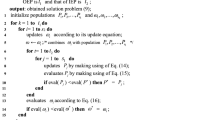Abstract
Linear bi-level programming (LBLP) is a useful tool for modeling decentralized decision-making problems. It has two-level (upper-level and lower-level) objectives. Many studies have shown that the LBLP problem is NP-hard, meaning it is difficult to find a global solution in polynomial time. In this paper, we present a novel cognitively inspired computing method based on the state transition algorithm (STA) to obtain an approximate optimal solution for the LBLP problem in polynomial time. The proposed method is applied to a supply chain model that fits the definition of an LBLP problem. The experimental results indicate that the proposed method is more efficient in terms of solution accuracy through a comparison to other metaheuristic-based methods using four problems from the literature in addition to the supply chain distribution model. In this study, a cognitively inspired STA-based method was proposed for the LBLP problem. In the future, we expect to extent the proposed method for linear multi-level programming problems.






Similar content being viewed by others
References
Bard JF. Practical bilevel optimization: algorithms and applications. Springer Science & Business Media; 2013. vol. 30.
Bard JF, Falk JE. An explicit solution to the multi-level programming problem. Comput Oper Res 1982;9 (1):77–100.
Bialas W F, Karwan MH. Two-level linear programming. Manag Sci 1984;30(8):1004–1020.
Dempe S. 2002. Foundations of bilevel programming. Springer Science & Business Media.
Han J, Yang C, Zhou X, Gui W. Dynamic multi-objective optimization arising in iron precipitation of zinc hydrometallurgy. Hydrometallurgy 2017;173:134–148.
Han J, Yang C, Zhou X, Gui W. A new multi-threshold image segmentation approach using state transition algorithm. Appl Math Model 2017;44:588–601.
Han J, Yang C, Zhou X, Gui W. A two-stage state transition algorithm for constrained engineering optimization problems. Int J Control Autom Syst 2017:1–13.
Hansen P, Jaumard B, Savard G. New branch-and-bound rules for linear bilevel programming. SIAM J Sci Statist Comput 1992;13(5):1194–1217.
He X, Li C, Huang T, Li C, Huang J. A recurrent neural network for solving bilevel linear programming problem. IEEE Trans Neural Netw Learn Syst 2014;25(4):824–830.
Reza Hejazi S, Memariani A, Jahanshahloo G, Sepehri MM. Linear bilevel programming solution by genetic algorithm. Comput Oper Res 2002;29(13):1913–1925.
Huang M, Zhou X, Huang T, Yang C, Gui W. Dynamic optimization based on state transition algorithm for copper removal process. Neural Comput and Applic. 2017:1–13.
Javed SG, Majid A, Ali S, Kausar N. A bio-inspired parallel-framework based multi-gene genetic programming approach to denoise biomedical images. Cogn Comput 2016;8(4):776–793.
Kim S-S, McLoone S, Byeon J-H, Lee S, Liu H. Cognitively inspired artificial bee colony clustering for cognitive wireless sensor networks. Cogn Comput 2017;9(2):207–224.
Kuo R J, Han Y S. A hybrid of genetic algorithm and particle swarm optimization for solving bi-level linear programming problem–a case study on supply chain model. Appl Math Model 2011;35(8):3905–3917.
Kuo R J, Huang C C. Application of particle swarm optimization algorithm for solving bi-level linear programming problem. Comput Math Appl 2009;58(4):678–685.
Li C, Xu Y, Yu X, Ryan C, Huang T. Risk-averse energy trading in multienergy microgrids: a two-stage stochastic game approach. IEEE Trans Indus Inf 2017;13(5):2620–2630.
Li C, Yu X, Yu W, Chen G, Wang J. Efficient computation for sparse load shifting in demand side management. IEEE Trans Smart Grid 2017;8(1):250–261.
Liu Y-H, Hart SM. Characterizing an optimal solution to the linear bilevel programming problem. Eur J Oper Res 1994;73(1):164–166.
Lv Y, Wan Z. Solving linear bilevel programs via a new neural network. Artif Intell Res 2015;5(1):49.
Mathieu R, Pittard L, Anandalingam G. Genetic algorithm based approach to bi-level linear programming. Oper Res 1994;28(1):1–21.
Safaei N, Saraj M. A new method for solving fully fuzzy linear bi-level programming problems. Int J Appl Oper Res 2014;4(1):39–46.
Siddique N, Adeli H. Nature-inspired chemical reaction optimisation algorithms. Cogn Comput. 2017:1–12.
Wen U-P, Hsu S-T. Linear bi-level programming problems–a review. J Oper Res Soc. 1991:125–133.
Wen U-P, Yang YH. Algorithms for solving the mixed integer two-level linear programming problem. Comput Oper Res 1990;17(2):133–142.
White DJ, Anandalingam G. A penalty function approach for solving bi-level linear programs. J Glob Optim 1993;3(4):397–419.
Zhang F, Yang C, Zhou X, Gui W. Fractional-order pid controller tuning using continuous state transition algorithm 2006:1–10. Neural Comput Applic 2018;29(10):795–804.
Zheng Y, Fang D, Wan Z. A solution approach to the weak linear bilevel programming problems. Optimization 2016;65(7):1437–1449.
Zhou X, Gao DY, Simpson AR. Optimal design of water distribution networks by a discrete state transition algorithm. Eng Optim 2016;48(4):603–628.
Zhou X, Gao DY, Yang C, Gui W. Discrete state transition algorithm for unconstrained integer optimization problems. Neurocomputing 2016;173:864–874.
Zhou X, Shi P, Lim C-C, Yang C, Gui W. A dynamic state transition algorithm with application to sensor network localization. Neurocomputing 2018;273:237–250.
Zhou X, Yang C, Gui W. State transition algorithm. J Indus Manag Optim 2012;8(4):1039–1056.
Zhou X, Yang C, Gui W. Nonlinear system identification and control using state transition algorithm. Appl Math Comput 2014;226:169–179.
Funding
This study was funded by the National Natural Science Foundation of China (grant numbers 61503416, 61533020, 61533021, 61590921), the 111 Project (grant number B17048), the Innovation-Driven Plan in Central South University (grant number 2018CX012), and Hunan Provincial Natural Science Foundation of China (Grant No. 2018JJ3683).
Author information
Authors and Affiliations
Corresponding author
Ethics declarations
Conflict of Interest
The authors declare that they have no conflict of interest.
Ethical Approval
This article does not contain any experiments with human or animal participants performed by any of the authors.
Informed Consent
Informed consent was obtained from all individual participants included in the study.
Rights and permissions
About this article
Cite this article
Huang, Z., Yang, C., Zhou, X. et al. A Novel Cognitively Inspired State Transition Algorithm for Solving the Linear Bi-Level Programming Problem. Cogn Comput 10, 816–826 (2018). https://doi.org/10.1007/s12559-018-9561-1
Received:
Accepted:
Published:
Issue Date:
DOI: https://doi.org/10.1007/s12559-018-9561-1




